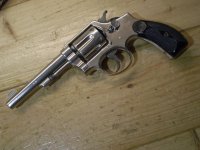The case hardening is usually still present unless the pre-bluing polishing was so agressive that it cut the metal down below it. That would be removing anywhere from about .004 to .010" from the surfaces generally.
The metal doesn't take a 'case' depth evenly over the entire surface especially on complicated shape parts.
That colors themselves are just on top of the case hardening.
The colors are measured in Microns in thickness.
They are very easily removed from the surfaces during any polishing even w/o removing any of the metal from the surface.
Some casehardening colors wear better than others. Just an end effect of the process used. Lots of variables involved.
;;In attempts to avoid parts warping, a shop I worked in tweaked the process so as to still get vibrant colors but avoiding any real case hardening.
The parts were soft.
But the colors were easily worn off the surfaces as well.
Many of the completed guns showed wear on the edges of the C/Colored frames and parts after simply being re-assembled.
Nice if you wanted a 90%+ gun.
Guns that were actually used had trouble with galling as well.
If you 'strip' a case colored part, simply chemically remove the case color and then blue the part,,quite often the swirl/cloud pattern of the original color case hardening will show in the new bluing.
Parts that are case hardened and are going to be re-case hardened should be first annealed (softened) for best results and color.
Heating the stripped parts to about 1100F and let them cool on their own.
A small furnace with controls and a steel box to place the parts in covered with charcoal works very nicely.
The charcoal burns and gives off CO so the air (oxygen)can't get at it. That way you don't get any heat scale on the parts. Easy to clean up.
Or just heat them up to the 1100 and then cover them with wood ashes or sand and let them cool. Then remove the heat scale with dilute muriatic acid.
Case colors can be replicated with cold blue quite well. Different brands work differently and work best if the steel is not hardened.
The breech bolt & trigger on a Meriden Model 1915 Pump 22 are faux CaseColor
Done w/ Cold Blue








